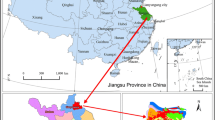Abstract
In this study, three-phase satellite images were used to define rules for the allocation of time and space in construction land resources based on a complex adaptive system and game theory. The decision behavior and rules of government agent, enterprise agent and resident agent in construction land growth were explored. A distinctive and dynamic simulation model of construction land growth was built, which integrated multi-agent, GIS technology and RS data and described the interaction among influencing agents. Taking Fuyang City in the Changjiang River Delta as an example, an assessment process for the remote sensing data in construction land and scenario planning was constructed. Repast and ArcGIS were used as simulation platforms. A simulation of the spatial pattern in land-use planning and the setting of scenario planning were conducted by using the incomplete active game, which was based on different natural, social and economic levels. Through this model, a simulation of urban planning space and decision-making for Fuyang City was created. Relevant non-structured problems arising from urban planning management could be identified, and the process and logic of urban planning spatial decision-making could thus be improved. Cel1-by-cel1 comparison showed that the simulation accuracy was over 72%. This model has great potential for use by government and town planners in decision support and technique support in the policy-making process.
Similar content being viewed by others
References
Armesto J, Manuschevich D, Mora A et al., 2010. From the holocene to the anthropocene: A historical framework for land cover change in southwestern South America in the past 15 000 years. Land Use Policy, 27(2): 148–160. doi: 10.1016/j.landusepol.2009.07.006
BomPard E, Carpaneto E, Carpaneto E et al., 2007. A game theory simulator for assessing the performances of competitive electricity markets. Electric Power Systems Research, 78(2): 217–227. doi: 10.1016/j.epsr.2007.02.007
Deng J S, Wang K, Hong Y et al., 2009. Spatio-temporal dynamics and evolution of land use change and landscape pattern in response to rapid urbanization. Landscape and Urban Planning, 92(3-4): 187–198. doi: 10.1016/j.landurbplan.2009.05. 001
Ding Han, 2006. Land Use /Land Cover Changes, Driving Force Analysis and Prediction in the Developed Coastal Region in China: A Case Study in Zhejiang Province (PhD Dissertation). Hangzhou: Zhejiang University. (in Chinese)
Fuyang Municipal Bureau of Statistics, 1997. Fuyang Statistical Yearbook 1996. Fuyang: China Statistics Press. (in Chinese)
Fuyang Municipal Bureau of Statistics, 2005. Fuyang Statistical Yearbook 2004. Fuyang: China Statistics Press. (in Chinese)
Fuyang Municipal Bureau of Statistics, 2010. Fuyang Statistical Yearbook 2009. Fuyang: China Statistics Press. (in Chinese)
He C Y, Okada N, Zhang Q F et al., 2008. Modelling dynamic urban expansion processes incorporating a potential model with cellular automata. Landscape and urban planning, 86(1): 79–91. doi: 10.1016/j.landurbplan.2007.12.010
Li Xia, Liu Xiaoping, 2008. Embedding sustainable development strategies in agent-based models for use as a planning tool. International Journal of Geographical Information Science, 22(1): 21–45. (in Chinese)
Li Xia, Ye Jiaan, Liu Xiaoping, 2007. Geographical Simulation Systems: Cellular Automaton and Multi-agent System. Beijing: Science Press. (in Chinese)
Ligmann Z A, Sun L, 2010. Applying time-dependent variancebased global sensitivity analysis to represent the dynamics of an agent-based model of land use change. International Journal of Geographical Information Science, 24(12): 1829–1850. doi: 10.1080/13658816.2010.490533
Ligtenberg A, Monica W, Arnold K B et al., 2004. A design and application of a multi-agent system for simulation of multi-actor spatial planning. Journal of Environment Management, 72(1–2): 43–55. doi: 10.1016/j.jenvman.2004.02.007
Liu Hui, 2009. Research on Urban Land Expansion and Planning Scenarios Simulation (PhD Dissertation). Wuhan: Wuhan University. (in Chinese)
Liu Xiaoping, Li Xia, Ai Bin et al., 2006. Multi-agent systems for simulating and planning land use development. Acta Geographica Sinica, 61(10): 1101–1112. (in Chinese)
Liu Xiaoping, Li Xia, Chen Yimin et al., 2010. Agent-based model of residential location. Acta Geographica Sinica, 65(6): 695–707. (in Chinese)
Liu Xiaoping, Li Xia, Yeh A G O et al., 2006. Multi-agent systems for simulating spatial decision behaviors and land use dynamics. Science in China: Series D, 36(11): 1027–1036. doi: 10.1007/s11430-006-1184-9
Matthews R B, Gilbert N G, Roach A et al., 2007. Agent-based land-use models: A review of applications. Landscape Ecology, 22(10): 1447–1459. doi: 10.1007/s10980-007-9135-1
Monticino M, Acevedo M, Callicot B et al., 2007. Coupled human and natural systems: A multi-agent based approach. Environment Modelling & Software, 22(5): 656–663. doi: 10.1016/j.envsoft.2005.12.017
Tao Haiyan, Li Xia, Chen Xiaoxiang et al., 2007. Method exploration of geographical spatial differentiation based on mutilagent: A case study of urban residential simulations. Acta Geographica Sinica, 62(6): 579–588. (in Chinese)
Valbuena D, Verburg P H, Bregt A K et al., 2010. An agentbased approach to model land-use change at a regional scale. Landscape Ecology, 25(2): 185–199. doi: 10.1007/s10980-009-9380-6
Vitabile S, Conti V, Militello C et al., 2009. An extended JADE-S based framework for developing secure Multi-Agent Systems. Computer Standards & Interfaces, 31(5): 913–930. doi: 10.1016/j.csi.2008.03.017
Xuan Huiyu, Zhang Fa, 2008. Complex System Simulation and Application. Beijing: Tsinghua University Press. (in Chinese)
Zhang Honghui, Zeng Yongnian, Jin Xiaobin, 2008. Urban land expansion model based on multi-agent system and application. Acta Geographica Sinica, 63(8): 869–881. (in Chinese)
Author information
Authors and Affiliations
Corresponding author
Additional information
Foundation item: Under the auspices of National Science and Technology Support Program of China (No. 2012BAH29B04-00)
Rights and permissions
About this article
Cite this article
Zhang, J., Wang, K., Song, G. et al. Application of multi-agent models to urban expansion in medium and small cities: A case study in Fuyang City, Zhejiang Province, China. Chin. Geogr. Sci. 23, 754–764 (2013). https://doi.org/10.1007/s11769-013-0636-3
Received:
Accepted:
Published:
Issue Date:
DOI: https://doi.org/10.1007/s11769-013-0636-3




